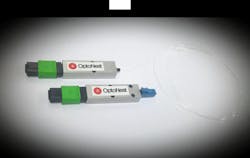MPO splitter is configured as LC-to-MPO fiber connectors
CablingInstall's sister publication Lightwave reports that Korea’s OptoNest Corp. has unveiled an optical MPO splitter that features an LC-type connector input and a 12-channel MPO connector as the output port.
The splitter, which conforms to TIA/EIA 604-5 and IEC 61754-7 standards and is suitable for RoHS requirements, measures 82x12x8 mm and is designed to remove the chance of performance degradation from bending or folding of the optical fiber cable. The splitter is designed not to expose the fiber-optic cable in between.
OptoNest is aiming the splitter at fiber to the home (FTTH) and 5G mobile network applications. The splitter’s plug-type design makes it easy to work with for both installation and maintenance, says the company. OptoNest can provide the optical MPO splitter with various types of fan-outs and cables as needed, adds the company.
The splitter will be on display at OFC 2020 in San Diego, CA, March 10-12, in Booth #2133 within the event's Korean Pavilion.
